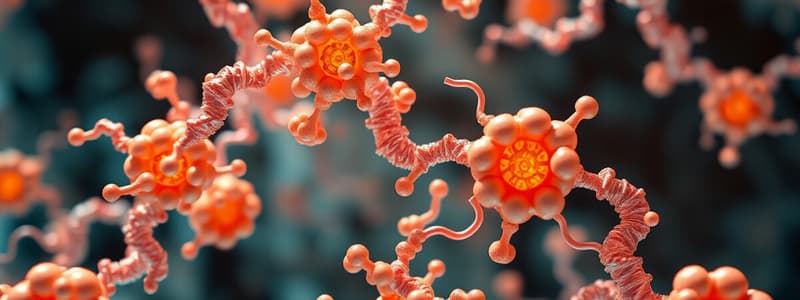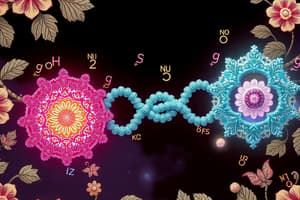Podcast
Questions and Answers
What is the primary difference between the induced fit model and the lock-and-key model of enzyme activity?
What is the primary difference between the induced fit model and the lock-and-key model of enzyme activity?
- The lock-and-key model is more widely accepted in biochemical research than the induced fit model.
- The induced fit model suggests a rigid binding, while the lock-and-key model suggests flexible binding.
- The induced fit model allows for conformational changes in the enzyme, while the lock-and-key model does not. (correct)
- The lock-and-key model involves substrate saturation levels that are not present in the induced fit model.
Which statement about the equilibrium dissociation constant (Kd) is true?
Which statement about the equilibrium dissociation constant (Kd) is true?
- Higher Kd values correlate with lower affinity between ligand and protein. (correct)
- Kd is a measure of the time taken for a ligand to dissociate from a protein.
- A lower Kd indicates a higher concentration of ligand needed to occupy the protein.
- Kd signifies the concentration of ligands at which half of the proteins are unoccupied.
In the context of protein-ligand binding, what effect does an increase in Ka have on ligand affinity?
In the context of protein-ligand binding, what effect does an increase in Ka have on ligand affinity?
- It decreases the likelihood of ligand binding to the protein.
- It reflects an increase in binding affinity for the ligand. (correct)
- It suggests that the protein is less stable when ligands are present.
- It indicates a lower rate of reaction occurring at equilibrium.
Which of the following statements about equilibrium in reactions is correct?
Which of the following statements about equilibrium in reactions is correct?
What does θ represent in the context of protein binding, and how is it typically calculated?
What does θ represent in the context of protein binding, and how is it typically calculated?
What causes the conformational change in myoglobin upon oxygen binding?
What causes the conformational change in myoglobin upon oxygen binding?
Which statement best describes the role of the iron ion in the heme group of myoglobin?
Which statement best describes the role of the iron ion in the heme group of myoglobin?
Which of the following transitions occurs in hemoglobin as it binds oxygen?
Which of the following transitions occurs in hemoglobin as it binds oxygen?
What is the functional significance of the T to R state conversion in hemoglobin?
What is the functional significance of the T to R state conversion in hemoglobin?
What role does the heme group play in the function of myoglobin and hemoglobin?
What role does the heme group play in the function of myoglobin and hemoglobin?
What is the primary mechanism by which the Bohr effect enhances oxygen release from hemoglobin?
What is the primary mechanism by which the Bohr effect enhances oxygen release from hemoglobin?
Which of the following best illustrates the physiological significance of the Bohr effect in active tissues?
Which of the following best illustrates the physiological significance of the Bohr effect in active tissues?
How does the Bohr effect influence hemoglobin's oxygen binding affinity at the molecular level?
How does the Bohr effect influence hemoglobin's oxygen binding affinity at the molecular level?
Which statement accurately describes the conditions that lead to the Bohr effect?
Which statement accurately describes the conditions that lead to the Bohr effect?
What role does the Bohr effect play in enhancing oxygen delivery during exercise?
What role does the Bohr effect play in enhancing oxygen delivery during exercise?
Flashcards are hidden until you start studying
Study Notes
Induced Fit vs. Key and Lock Model
- Induced Fit Model: Enzyme undergoes conformational changes upon binding to substrate, enhancing affinity for a better fit.
- Key and Lock Model: Active site is rigid and pre-formed to match the substrate perfectly, like a key fitting into a lock.
Advantages of Induced Fit
- Greater flexibility: Allows enzyme to bind to a broader range of substrates with varying shapes.
- More efficient catalysis: Conformational changes can optimize enzyme-substrate interactions for better catalytic activity.
Advantages of Key and Lock Model
- Specificity: Provides high specificity for a particular substrate, preventing undesired reactions.
Equilibrium
- Definition: A state where the rate of forward and reverse reactions are equal, resulting in no net change in the concentrations of reactants and products.
- Dynamic process: Reactions continue, but the concentrations remain constant.
Equilibrium Dissociation Constant (Kd)
- Definition: Concentration of ligand required to occupy half of the protein binding sites at equilibrium.
- Inversely proportional to affinity: High Kd indicates low affinity (requires a higher ligand concentration for binding), and vice versa.
Relationship between Kd and θ (Fraction of Occupied Protein)
- Equation: Kd = [L] * (1 - θ) / θ
- Interpretation: Kd is the ratio of free ligand to occupied protein at equilibrium.
- Higher Kd: Represents lower affinity, needing a higher ligand concentration to occupy half the binding sites.
- Lower Kd: Represents higher affinity, reaching half occupation at a lower ligand concentration.
Hemoglobin T-R State
- Hemoglobin can exist in two states: T (tense) and R (relaxed)
- T state has lower affinity for oxygen, while R state has higher affinity
- Oxygen binding triggers conformational change from T to R state
Bohr Effect
- Bohr effect describes the relationship between pH and hemoglobin's oxygen binding affinity
- Lower pH (more acidic) decreases oxygen binding affinity
- Higher pH (more basic) increases oxygen binding affinity
Bohr Effect and Oxygen Transportation
- During exercise, muscles produce CO2, which contributes to increased acidity in the blood
- Lower pH in the blood environment promotes oxygen release from hemoglobin, delivering oxygen to active tissues
- As blood flows through the lungs, CO2 is exhaled and pH increases, promoting oxygen uptake by hemoglobin
Studying That Suits You
Use AI to generate personalized quizzes and flashcards to suit your learning preferences.




